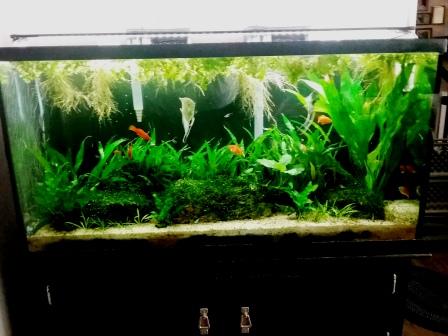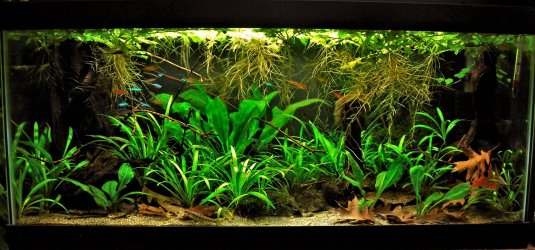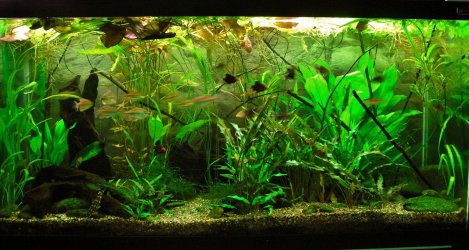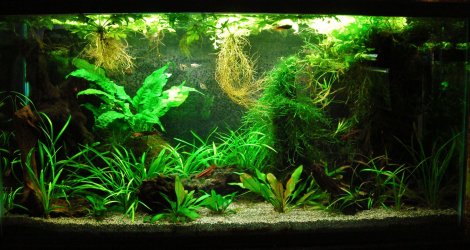Geigetron343
New Member
- Joined
- Sep 29, 2018
- Messages
- 15
- Reaction score
- 0
Hey everyone! I'm new to this forum, and I hope it's okay digging up a thread from years ago (if not, sorry in advance). This is literally my first post. The topic seems important to hobbyists and quite misunderstood to many. I think I have some valid comments with regard to aquarium plants and nitrate management, and I hope you find the post useful.
To substantiate my claims, I'm going to add some pictures of the tanks I'm currently running. I have three tanks, all planted, ranging from high light/high tech/high CO2, to low light/low tech/no added CO2. I've had a pretty high success rate with both fish and plants in all tanks. Plants only seem to do poorly if there is an algae outbreak, and the leaves get coated with the stuff. It has really only been an issue for one tank, and honestly its not very bad (I've seen much worse).
It seems universally agreed upon (by experienced and serious aquarists) that adding chemicals to your tank should only be done as a last resort. It seems very convenient, but it should be avoided... and on topic with this thread, it is much more expensive than water changes. Spend that money on some new fish .
.
In my personal experience, plants have certainly proven themselves effective for nitrate control. They soak up all the bad stuff (it's good to them!) while releasing oxygen that your fish will appreciate. In addition to the benefits to you water parameters, plants make an aquarium look organic and beautiful (sometimes even stunning) when properly placed. One more benefit is that fish love to hide and swim amongst the stems and leaves--it makes them feel more at ease, and plants are even required to coax certain fish into breeding.
As for the comments about needing many plants and few fish in order to keep nitrates down, it is, at least from my experience, false. I have 23 fish and between one and two dozen ghost shrimp in my high-tech 75, and I do almost ZERO WCs! I've occasionally used a plastic pitcher to skim the water's surface, to remove a thin film of tannin seepage (from driftwood). Other than that, I perform an EXTREMELY SMALL (about 5 or 10%) WC My ammonia and nitrite levels always read zero, unless I add several fish at once (then they may reach up to 5ppm). Nitrite levels stay between 5 and 20ppm.

In my low-light/low-tech/no CO2 75, there 18 hardy fish. I have perform water changes a bit more frequently on this (about 10-15% every week) because they're all hard fish, and feed them a ton. on that one, because they're all heavy eaters, and they're all getting fairly large. Nitrates stays a bit higher in this one (20-40ppm) as the plants don't use as much, being a low-light setup. About zero ammo and nitrites.

Finally, my 29 low-tech/light/CO2, has only three fish: two peacock cichlids and a bristlenose plec (currently trying to find good tank mates to add). They aren't huge and don't eat a ton, but I haven't performed a WC in weeks and nitrates stay between 5 and 10ppm. Again, virtually zero ammo and nitrites.

I understand that aquarium plants aren't for everyone. They do require some upkeep (trimming back, re-planting, propagating, etc.) and nutrient dosing isn't free (though it also isn't always necessary). However, they are a great addition if you like the look and dislike massive and frequent WCs. Hope this post is useful!
To substantiate my claims, I'm going to add some pictures of the tanks I'm currently running. I have three tanks, all planted, ranging from high light/high tech/high CO2, to low light/low tech/no added CO2. I've had a pretty high success rate with both fish and plants in all tanks. Plants only seem to do poorly if there is an algae outbreak, and the leaves get coated with the stuff. It has really only been an issue for one tank, and honestly its not very bad (I've seen much worse).
It seems universally agreed upon (by experienced and serious aquarists) that adding chemicals to your tank should only be done as a last resort. It seems very convenient, but it should be avoided... and on topic with this thread, it is much more expensive than water changes. Spend that money on some new fish
In my personal experience, plants have certainly proven themselves effective for nitrate control. They soak up all the bad stuff (it's good to them!) while releasing oxygen that your fish will appreciate. In addition to the benefits to you water parameters, plants make an aquarium look organic and beautiful (sometimes even stunning) when properly placed. One more benefit is that fish love to hide and swim amongst the stems and leaves--it makes them feel more at ease, and plants are even required to coax certain fish into breeding.
As for the comments about needing many plants and few fish in order to keep nitrates down, it is, at least from my experience, false. I have 23 fish and between one and two dozen ghost shrimp in my high-tech 75, and I do almost ZERO WCs! I've occasionally used a plastic pitcher to skim the water's surface, to remove a thin film of tannin seepage (from driftwood). Other than that, I perform an EXTREMELY SMALL (about 5 or 10%) WC My ammonia and nitrite levels always read zero, unless I add several fish at once (then they may reach up to 5ppm). Nitrite levels stay between 5 and 20ppm.
In my low-light/low-tech/no CO2 75, there 18 hardy fish. I have perform water changes a bit more frequently on this (about 10-15% every week) because they're all hard fish, and feed them a ton. on that one, because they're all heavy eaters, and they're all getting fairly large. Nitrates stays a bit higher in this one (20-40ppm) as the plants don't use as much, being a low-light setup. About zero ammo and nitrites.
Finally, my 29 low-tech/light/CO2, has only three fish: two peacock cichlids and a bristlenose plec (currently trying to find good tank mates to add). They aren't huge and don't eat a ton, but I haven't performed a WC in weeks and nitrates stay between 5 and 10ppm. Again, virtually zero ammo and nitrites.
I understand that aquarium plants aren't for everyone. They do require some upkeep (trimming back, re-planting, propagating, etc.) and nutrient dosing isn't free (though it also isn't always necessary). However, they are a great addition if you like the look and dislike massive and frequent WCs. Hope this post is useful!








